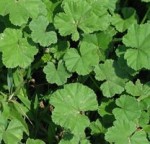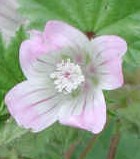 A native of Europe and Asia, common mallow is a spreading annual or biennial found throughout the United States. It is a relative of hollyhocks, cotton, okra and hibiscus and prefers sunny sites with fertile, mesic to dry soil but does well with less. It grows in disturbed areas such as gardens, lawns, croplands, abandon fields, vacant lots, roadsides and other waste areas.
A native of Europe and Asia, common mallow is a spreading annual or biennial found throughout the United States. It is a relative of hollyhocks, cotton, okra and hibiscus and prefers sunny sites with fertile, mesic to dry soil but does well with less. It grows in disturbed areas such as gardens, lawns, croplands, abandon fields, vacant lots, roadsides and other waste areas.
 Description: Young plants of common mallow are small loose rosettes comprised of a few medium green
Description: Young plants of common mallow are small loose rosettes comprised of a few medium green  roundish leaves. Later the plant produces an erect, hairy stem that branches freely at the base and lies close to the soil with tips growing upward. As the stems become longer and more numerous the plant can form a loose mound. The stem leaves are alternate, hairy on both sides, and are borne on long petioles. They are circular to kidney-shaped, 2.5” -3”, lobed, and resemble geranium leaves. The flowers appear in clusters of 1-3, in the leaf axils, from late spring through summer and are light pink to white, and sometimes striped. The flowers are followed by round, flattened fruits carrying numerous seeds and resembling discs of cheese giving the plant the common name of cheeseweed. The root system is a thick taproot that can become deep with age.
roundish leaves. Later the plant produces an erect, hairy stem that branches freely at the base and lies close to the soil with tips growing upward. As the stems become longer and more numerous the plant can form a loose mound. The stem leaves are alternate, hairy on both sides, and are borne on long petioles. They are circular to kidney-shaped, 2.5” -3”, lobed, and resemble geranium leaves. The flowers appear in clusters of 1-3, in the leaf axils, from late spring through summer and are light pink to white, and sometimes striped. The flowers are followed by round, flattened fruits carrying numerous seeds and resembling discs of cheese giving the plant the common name of cheeseweed. The root system is a thick taproot that can become deep with age.

 Control: Young plants are easily removed by hoeing or hand pulling and slip easily out of wet soil. They can also be cut at the crown line. As the plants mature and develop a deeper taproot they are more difficult to remove by pulling and may resprout if broken or cut. A preemergent herbicide prevents seeds from germinating. Most herbicides available to home users are not effective; 2,4-D gives limited control.
Control: Young plants are easily removed by hoeing or hand pulling and slip easily out of wet soil. They can also be cut at the crown line. As the plants mature and develop a deeper taproot they are more difficult to remove by pulling and may resprout if broken or cut. A preemergent herbicide prevents seeds from germinating. Most herbicides available to home users are not effective; 2,4-D gives limited control.